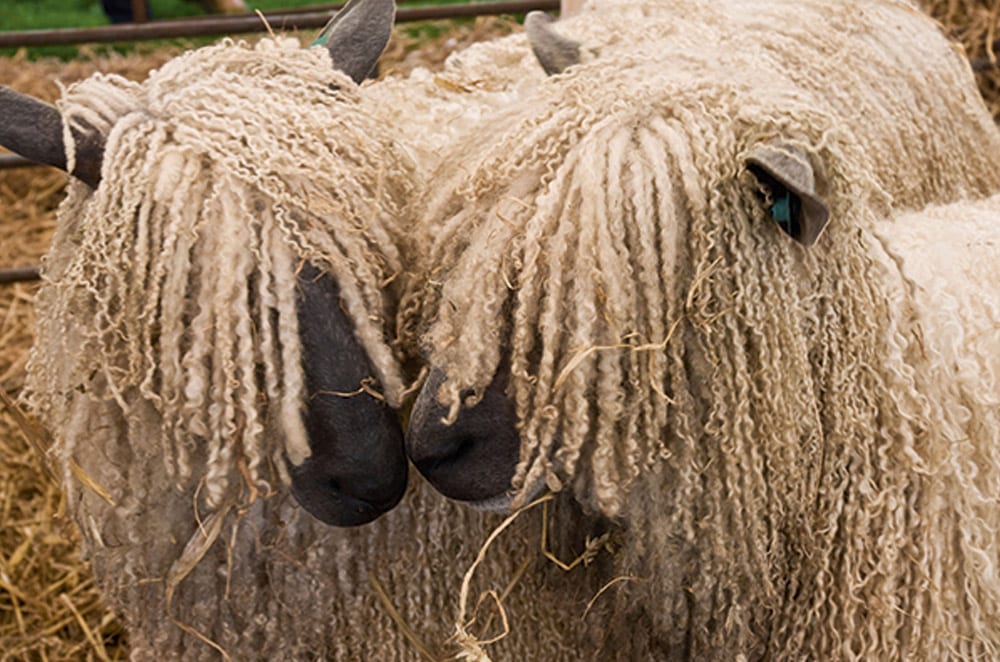
Exmoor Horn
Originating from Exmoor, this sheep is a white faced hardy breed suited to the high moorland. It is an effective grazer for sensitive landscapes and they thrive off sparse upland hill pasture. Over many generations the Exmoor Horn has adapted perfectly to this environment, by grazing these distinctive pastures they produce lamb of outstanding flavour and texture.
***********************************************************************************************************************************************
Gotland Sheep
Named after the Swedish Island of Gotland, these sheep are fine boned and of medium size. The fleece is fine, long and dense with lustrous curls that consist of many shades of grey, from silver to charcoal grey and almost black. They have a metallic sheen to the wool occasionally appearing purple or lilac in certain lights. As J.R.R Tolkien wrote in describing the Gotland wool “the hue of twilight, or dusk-silver as water under the stars”.
***********************************************************************************************************************************************
Teeswater Sheep
Bred in Northern England for about two hundred years the breed is native to the Teesdale area of County Durham. The Teeswater has very fine wool that is long-stapled, usually of high lustre with each lock hanging free in a gentle permanent curl; the fleece is also kemp free. These sheep have a docile temperament yet remain intelligent and alert.
***********************************************************************************************************************************************
Merino Sheep
Originating from Spain, the modern Merino was domesticated in New Zealand and Australia. They are an economically influential breed prized for its wool, the wool is the finest and softest of any sheep. An excellent forager and very adaptable, the sheep is bred primarily for its wool which must be shorn at least once a year as the wool does not stop growing. Poll Merinos have no horns or very small stubs and horned Merino rams have long spiral horns.
***********************************************************************************************************************************************
Wensleydale Sheep
Originating in Wensleydale in the region of North Yorkshire, this breed was developed in the 19th century by crossing the English Leicester and the Teeswater Sheep. Wensleydale’s have a blue/grey face and are the largest and heaviest of all sheep breeds; they are renowned for their ringlet dreadlocks of wool. There is a separate section in the breed register for black Wensleydale which can be jet black through to a silver grey, the tips of the fleece then weather to a ginger or a cream.
***********************************************************************************************************************************************
The Badger Face Welsh Mountain
A hardy upland breed known for good maternal instinct and producing a high percentage of twins and triplets under good conditions. There are two sub varieties of this breed which are the Torddu (black bellied) and the Torwen (white bellied). The Torwen colour pattern shows a strong similarity with the Soay and Mouflon, it is known that many breeds around the world carry the badger face gene.
***********************************************************************************************************************************************
Manx Loaghtan
The Manx is a hardy breed that is able to survive harsh conditions; they also require little additional feed. These sheep do well on rough grazing and they are an active browser, making it an ideal breed for most conservation grazing situations. The Manx is a long legged, fine boned, primitive breed with a warm brown fleece, face and legs. Ewes and Rams are horned, usually having four to six horns.
***********************************************************************************************************************************************
Racka Sheep
Known for its unusual spiral shaped horns, these beautiful sheep originate in Hungary. The wool is long, coarse and appears in two general types, cream wool with light brown faces and legs; there is also a black variation. Ewes and Rams both possess long spiral/corkscrew shaped horns that protrude almost straight upward from the top of the head. The breed is very adaptable and can live on any type of pasture, they do particularly well on the hardy open and dry plains of Hungary. The tips on the black variation fade to a reddish brown with exposure to sunlight, with age they will then turn to a grey.
***********************************************************************************************************************************************
Jacob Sheep
Originating in the Middle East, they are believed to be the oldest in the world, being mentioned in the Old Testament Book of Genesis. Due to their appearance, they were noticed by English Noblemen and imported; the breed has graced large estates and country homes of England for many centuries. The Jacob is rather striking, the horns are black or black and white striped; they are a small and hardy breed and very economical to feed. Jacobs can be bred to exhibit a specific look to suit each owners personal preference such as, percentage of colour, two or four horns, spotted legs or white legs and large spots or small on their fleece.
Shop our huge range of stunning, ethically sourced sheepskin products here.



